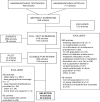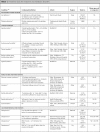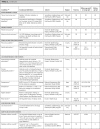Clinical review: Prevalence and incidence of endocrine and metabolic disorders in the United States: a comprehensive review
- PMID: 19494161
- PMCID: PMC5393375
- DOI: 10.1210/jc.2008-2291
Clinical review: Prevalence and incidence of endocrine and metabolic disorders in the United States: a comprehensive review
Abstract
Context: There has not been a comprehensive compilation of data regarding the epidemiology of all endocrine and metabolic disorders in the United States.
Evidence acquisition: We included 54 disorders with clinical and public health significance. We identified population-based studies that provided U.S. prevalence and/or incidence data by searching PubMed in December 2007 for English-language reports, hand-searching reference lists of six textbooks of endocrinology, obtaining additional resources from identified experts in each subspecialty, and searching epidemiological databases and web sites of relevant organizations. When available, we selected articles with data from 1998 or later. Otherwise, we selected the article with the most recent data, broadest geographical coverage, and most stratifications by sex, ethnicity, and/or age. Ultimately, we abstracted data from 70 articles and 40 cohorts.
Evidence synthesis: Endocrine disorders with U.S. prevalence estimates of at least 5% in adults included diabetes mellitus, impaired fasting glucose, impaired glucose tolerance, obesity, metabolic syndrome, osteoporosis, osteopenia, mild-moderate hypovitaminosis D, erectile dysfunction, dyslipidemia, and thyroiditis. Erectile dysfunction and osteopenia/osteoporosis had the highest incidence in males and females, respectively. The least prevalent conditions, affecting less than 1% of the U.S. population, were diabetes mellitus in children and pituitary adenoma. Conditions with the lowest incidence were adrenocortical carcinoma, pheochromocytoma, and pituitary adenomas. Certain disorders, such as hyperparathyroidism and thyroid disorders, were more common in females. As expected, the prevalence of diabetes mellitus was highest among ethnic minorities. Sparse data were available on pituitary, adrenal, and gonadal disorders.
Conclusions: The current review shows high prevalence and incidence of common endocrine and metabolic disorders. Defining the epidemiology of these conditions will provide clues to risk factors and identify areas to allocate public health and research resources.
Figures
References
-
- Cowie CC, Rust KF, Byrd-Holt DD, Eberhardt MS, Flegal KM, Engelgau MM, Saydah SH, Williams DE, Geiss LS, Gregg EW 2006. Prevalence of diabetes and impaired fasting glucose in adults in the U.S. population: National Health and Nutrition Examination Survey 1999–2002. Diabetes Care 29:1263–1268 - PubMed
-
- Mokdad AH, Bowman BA, Engelgau MM, Vinicor F 2001. Diabetes trends among American Indians and Alaska natives: 1990–1998. Diabetes Care 24:1508–1509 - PubMed
-
- Ford ES, Li C, Zhao G, Pearson WS, Mokdad AH 2008. Prevalence of the metabolic syndrome among U.S. adolescents using the definition from the International Diabetes Federation. Diabetes Care 31:587–589 - PubMed
-
- 2008 State-specific prevalence of obesity among adults—United States, 2007. MMWR Morb Mortal Wkly Rep 57:765–768 - PubMed
-
- Jemal A, Siegel R, Ward E, Hao Y, Xu J, Murray T, Thun MJ 2008. Cancer statistics, 2008. CA Cancer J Clin 58:71–96 - PubMed
Publication types
MeSH terms
Grants and funding
LinkOut - more resources
Full Text Sources
Other Literature Sources
Medical
Research Materials




